Hi Everyone!
Before to start on a very important topic to me …
I’d love to thank All of You who
read, liked and shared
my first article on this Blog,
last month!
The affection of the people
around us and what we do
is precious
to live a fulfilled life!
~ ~ ~ ~ ~
The first week of October, here in Italy,
we celebrated The Word Breastfeeding Week!
So I’ve decided to dedicate
this month’s post to
the greenest way
to grow up our children
therefore
to have a healthy new generation of adults;
to save a great amount of money
yet to feel in tune with Nature.
… to name a few terrific aspects of
Breastfeeding!
Let’s talk about this
nectar of the gods:
mother’s milk,
produced in the temple of love:
a woman body.
It is available 24 hours/day.
It is always at the ideal temperature.
It is ready to use as it is.
It is sterile.
It is free of charge
yet its value is priceless.
It strenghtens a baby’s immune system.
It’s rich in water, carbohydrates, proteins and lipids.
It’s unique, inimitable, species specific.
It offers affection, warmth and security
yet an amazing way to continue
the bonding between mother&child
that started in the womb.
It changes from the childbirth towards the next months
and also according to the time of the day
to meet the baby’s needs.
It is a LIVE tissue
that every mother has got especially for her own child.
Breastfeeding is a Universal gesture of Love
we can do it
everywhere
anytime
in any culture.
When a baby is born
the top choice to feed him
is throught his mom’s breasts.
When this is not possible,
his mother’s milk comes
squeezed by a breast pump
and preferibly given with a little spoon.
Then comes another mother’s milk.
Finally there is the formula.
Nature has given us everything we need
to successfully keep alive
we all Humans.
Everything we need
is within us.
And for all the people
who care about the health
of the Planet
this is indeed
the greenest way to go
… even if the drink is white!
~ ~ ~ ~ ~
Breastfeeding is a choice,
apart from all that said above.
There are women who, for different reasons
choose
to feed their babies with a bottle.
It is vital to inform
in order to have
aware and happy
motherbabies.
~ ~ ~ ~ ~
This is my
Simple, Quick
Fun and Cheap
contribution for October!
I wish everyone
a lovely month ahead,
enjoying the warm colors
of the Nature outdoor
and the warmth
of Your beloved indoor!
Peace on Earth
and in
All Our Hearts

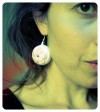
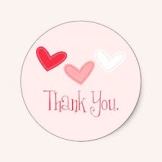
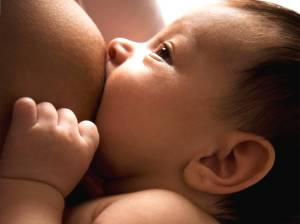
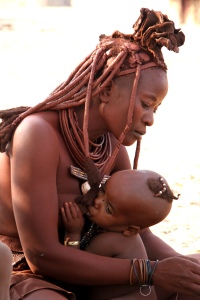
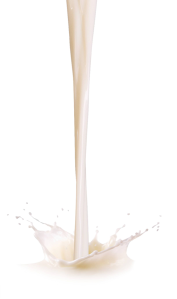





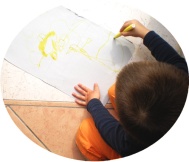


 Start with a clean no longer wanted t-shirt. I get many of my t-shirts from a local thrift store and then wash them in
Start with a clean no longer wanted t-shirt. I get many of my t-shirts from a local thrift store and then wash them in  Separate the torso area of the shirt from the chest area just below the graphic. If your shirt has no graphics or screen printing, separate it below the armpits.
Separate the torso area of the shirt from the chest area just below the graphic. If your shirt has no graphics or screen printing, separate it below the armpits. If any stains exist on the torso area make another cut. This shirt has a small blue ink stain.
If any stains exist on the torso area make another cut. This shirt has a small blue ink stain. Fold the remaining stain-free torso area so that the side folds are not even with one another (as shown in the picture).
Fold the remaining stain-free torso area so that the side folds are not even with one another (as shown in the picture). Insert a dowel or similar object (a small curtain rod will work, too) into the top fold. This object will prevent you from cutting all the way through the t-shirt.
Insert a dowel or similar object (a small curtain rod will work, too) into the top fold. This object will prevent you from cutting all the way through the t-shirt. Place a straight edge perpendicular to the dowel and use a rotary cutter to make 5/8″ strips (or whatever width you prefer).
Place a straight edge perpendicular to the dowel and use a rotary cutter to make 5/8″ strips (or whatever width you prefer). When you reach the bottom hem of the t-shirt while making strips, be careful not to cut through the stitching.
When you reach the bottom hem of the t-shirt while making strips, be careful not to cut through the stitching. Use a tube turner (blue object shown in the picture) to turn the bottom hem of the t-shirt inside out. This makes a really wonderful cord that you can use for other projects.
Use a tube turner (blue object shown in the picture) to turn the bottom hem of the t-shirt inside out. This makes a really wonderful cord that you can use for other projects. Pick up the area you just cut into 5/8″ strips, remove the dowel and insert your hand in it’s place.
Pick up the area you just cut into 5/8″ strips, remove the dowel and insert your hand in it’s place. Cut across the folder diagonally – this creates a continuous strip. Be careful not to cut straight across. If you do, you will end up with individual loops instead of a continuous strip.
Cut across the folder diagonally – this creates a continuous strip. Be careful not to cut straight across. If you do, you will end up with individual loops instead of a continuous strip. Stretch the strip (pile on the left) into cord (pile on the right).
Stretch the strip (pile on the left) into cord (pile on the right). Now that you have a pile of cord, take the end and wrap it once around your thumb.
Now that you have a pile of cord, take the end and wrap it once around your thumb. Wrap about 90% of the cord around your hand as shown in the picture.
Wrap about 90% of the cord around your hand as shown in the picture. Wrap the remaining cord using an alternating X pattern as shown.
Wrap the remaining cord using an alternating X pattern as shown. Wrap the end of the cord around one of the last wraps so the ball won’t unravel.
Wrap the end of the cord around one of the last wraps so the ball won’t unravel. Carefully remove the ball from your hand and the end of the cord from your thumb. Now you have a ball that is easy to use – simply pull cord from the center.
Carefully remove the ball from your hand and the end of the cord from your thumb. Now you have a ball that is easy to use – simply pull cord from the center. Pull a little extra cord from the center of the ball and wrap it around the ball.
Pull a little extra cord from the center of the ball and wrap it around the ball. Using the other portion of the torso (the part on the other side of the stain I cut away), I’ll make loops by cutting strips all the way through (no dowel this time). An alternate method of cutting and measuring strips is to make your own pre-measured strips out of cardboard and and use them as a guide for your straight edge.
Using the other portion of the torso (the part on the other side of the stain I cut away), I’ll make loops by cutting strips all the way through (no dowel this time). An alternate method of cutting and measuring strips is to make your own pre-measured strips out of cardboard and and use them as a guide for your straight edge. Simply stretch the strip and you get a cord loop. You can wrap it around your wrist to make a hip earth friendly bracelet.
Simply stretch the strip and you get a cord loop. You can wrap it around your wrist to make a hip earth friendly bracelet.
 Lay out the sleeves of the shirt and detach the sleeve hems. Be careful not to cut through the stitching on the hem.
Lay out the sleeves of the shirt and detach the sleeve hems. Be careful not to cut through the stitching on the hem. Turn the sleeve hems inside out just like we did with the bottom hem earlier. A tube turner makes this task a snap.
Turn the sleeve hems inside out just like we did with the bottom hem earlier. A tube turner makes this task a snap. Detach the sleeves and flip them upside down.
Detach the sleeves and flip them upside down. Remove the seam that runs along the underarm of the sleeve (now shown at the top because we flipped the sleeve).
Remove the seam that runs along the underarm of the sleeve (now shown at the top because we flipped the sleeve). Cut the remaining sleeve into strips and stretch the strips. These shorter strips are great for making your own Eco-friendly product tags!
Cut the remaining sleeve into strips and stretch the strips. These shorter strips are great for making your own Eco-friendly product tags! With the remainder of the shirt (the chest and back area), fold in half and line up the arm seams.
With the remainder of the shirt (the chest and back area), fold in half and line up the arm seams. Remove the arm seams.
Remove the arm seams. Spread out the front chest area of the shirt as shown.
Spread out the front chest area of the shirt as shown. Cut strips from the design free area between the top of the graphic and the collar. Save the collar and screen print area for other crafts (I’ll post tutorials for these soon).
Cut strips from the design free area between the top of the graphic and the collar. Save the collar and screen print area for other crafts (I’ll post tutorials for these soon). Spread out the back of the shirt the same way and cut more strips. I use the cords from the chest and back area to make my variegated t-shirt yarn (tutorial coming soon).
Spread out the back of the shirt the same way and cut more strips. I use the cords from the chest and back area to make my variegated t-shirt yarn (tutorial coming soon). With any leftover scraps, cut into pieces of about 1″ by 1″. These can be used as mulch in your garden if you collect enough.
With any leftover scraps, cut into pieces of about 1″ by 1″. These can be used as mulch in your garden if you collect enough. Here is a section of my garden with t-shirt yarn mulch. My husband says it looks like a clown exploded.
Here is a section of my garden with t-shirt yarn mulch. My husband says it looks like a clown exploded.
You must be logged in to post a comment.